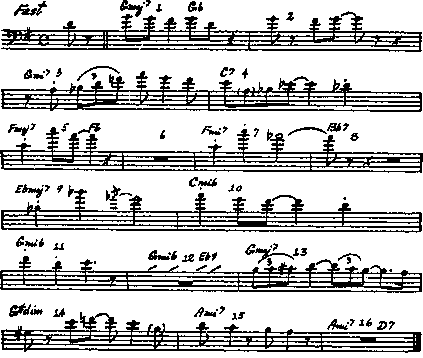The Book Of Jazz - online reference book
Its Nature, Instruments, Sources, Sounds, Development & Performers
| Share page | Visit Us On FB |
|
222 |
ITS NATURE |
||
|
|
|||
|
flurry of sixteenth notes, but given rhythm balance through the use of syncopation (third beat of Measure 5) and a triplet on the first beat of Measure 6. This serves as a warm-up for an even busier upward sweep in which the tension mounts; notice that the rise is diatonic, except that the flatted seventh (A Flat) and flatted third (C Sharp) are used. After this surge, a three beat pause for breath and thought (Measures 9-10) leads to another concept in which a buoyant mood is established, this time not by the multi-note fury of the preceding phrases but through a concept built symmetrically around a simple thought based on the three quarter notes at Measure 11, repeated at Measure 13 in the same descending pattern but with a different formation and an octave lower. Measure 15 is a superb example of the obliqueness of Gillespie's approach to a chord. The root of the F Minor 7th is preceded by notes on either side of it (E Natural and G); the ac- |
|||
|
jay jay johnson / Indiana Winter |
|||
 |
|||